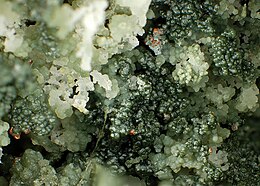
Summary
Saponite is a trioctahedral mineral of the smectite group. Its chemical formula is Ca0.25(Mg,Fe)3((Si,Al)4O10)(OH)2·n(H2O).[3] It is soluble in sulfuric acid. It was first described in 1840 by Svanberg. Varieties of saponite are griffithite, bowlingite and sobotkite.
| Saponite | |
|---|---|
 Saponite (light green) mixed with chamosite (dark green) and copper | |
| General | |
| Category | Phyllosilicates Smectite group |
| Formula (repeating unit) | Ca0.25(Mg,Fe)3((Si,Al)4O10)(OH)2·n(H2O) |
| IMA symbol | Sap[1] |
| Strunz classification | 9.EC.45 |
| Crystal system | Monoclinic |
| Crystal class | Prismatic (2/m) (same H-M symbol) |
| Space group | C2/m |
| Unit cell | a = 5.3 Å, b = 9.14 Å c = 16.9 Å; β = 97°; Z = 2 |
| Identification | |
| Color | White, yellow, red, green, blue |
| Crystal habit | Granular – Massive |
| Cleavage | {001} perfect |
| Tenacity | Brittle dry, plastic when hydrated |
| Mohs scale hardness | 1.5 |
| Luster | Greasy, dull |
| Streak | White |
| Diaphaneity | Translucent |
| Specific gravity | 2.24–2.30 |
| Optical properties | Biaxial (−) |
| Refractive index | nα = 1.479 – 1.490 nβ = 1.510 – 1.525 nγ = 1.511 – 1.527 |
| Birefringence | δ = 0.032 – 0.037 |
| Pleochroism | X = colorless, light yellow to green-brown; Y = Z = colorless, greenish brown to dark brown |
| 2V angle | Calculated: 20° to 26° |
| References | [2][3][4] |
It is soft, massive, and plastic, and exists in veins and cavities in serpentinite and basalt. The name is derived from the Greek sapo, soap. Other names include bowlingite; mountain soap; piotine; soapstone.
Occurrence edit
Saponite was first described in 1840 for an occurrence in Lizard Point, Landewednack, Cornwall, England.[3] It occurs in hydrothermal veins, in basalt vesicles, skarns, amphibolite and serpentinite. Associated minerals include celadonite, chlorite, native copper, epidote, orthoclase, dolomite, calcite and quartz.[4]
Saponite is found in Ząbkowice Śląskie in Silesia, Svärdsjö in Dalarna, Sweden and in Cornwall, UK. The soap stone of Cornwall is used in the porcelain factory. Saponite is also found in the "dark rims" of chondrules in carbonaceous chondrites and seen as a sign of aqueous alteration.[5] Europe's largest primary diamond deposit, Lomonosov, in the Primorsky District of Arkhangelsk Oblast is an area of intensive accumulation and storage of saponite at the tailings.
Application edit
The forecasted mass of saponite to be discharged into the tailings of diamond ore processing makes up millions of tons. Worryingly, when macro- and micro-components are found in non-hazardous concentrations, fewer efforts are put into the environmental management of the tailings, though technogenic sediments offer prospects for reuse and valorization beyond their traditional disposal. Saponite is a demonstrative example of the tailings constituent that is often left unfairly mistreated.
Electrochemical separation helps to obtain modified saponite-containing products with high smectite-group minerals concentrations, lower mineral particles size, more compact structure, and greater surface area. These characteristics open possibilities for the manufacture of high-quality ceramics and heavy-metal sorbents from saponite-containing products.[6] Furthermore, tail grinding occurs during the preparation of the raw material for ceramics; this waste reprocessing is of high importance for the use of clay pulp as a neutralizing agent, as fine particles are required for the reaction. Experiments on the Histosol deacidification with the alkaline clay slurry demonstrated that neutralization with the average pH level of 7.1 is reached at 30% of the pulp added and an experimental site with perennial grasses proved the efficacy of the technique. Moreover, the reclamation of disturbed lands is an integral part of the social and environmental responsibility of the mining company and this scenario addresses the community necessities at both local and regional levels.[7]
Synthetic saponites have defined chemical composition and reactive surface and serve as a substitute for zeolites. In contrast to the pores in zeolites, saponites have a larger layer spacing and can also be used as catalysts for larger organic molecules, e.g. in polymerization, isomerization and cracking.[8]
See also edit
- Classification of minerals
- Hectorite – Phyllosilicate clay mineral
- Nontronite – Phyllosilicate mineral
- List of minerals
References edit
- ^ Warr, L.N. (2021). "IMA–CNMNC approved mineral symbols". Mineralogical Magazine. 85 (3): 291–320. Bibcode:2021MinM...85..291W. doi:10.1180/mgm.2021.43. S2CID 235729616.
- ^ Webmineral data
- ^ a b c Mindat.org
- ^ a b Handbook of Mineralogy
- ^ Zolensky, Michael; Barrett, Ruth; Browning, Lauren (July 1993). "Mineralogy and composition of matrix and chondrule rims in carbonaceous chondrites". Geochimica et Cosmochimica Acta. 57 (13): 3123–3148. Bibcode:1993GeCoA..57.3123Z. doi:10.1016/0016-7037(93)90298-B.
- ^ Chanturiya, V.A.; Minenko, V.G.; Makarov, D.V. (2018). "Advanced Techniques of Saponite Recovery from Diamond Processing Plant Water and Areas of Saponite Application". Minerals. 8 (12): 549. Bibcode:2018Mine....8..549C. doi:10.3390/min8120549. This article incorporates text available under the CC BY 4.0 license.
- ^ Pashkevich, M.A.; Alekseenko, A.V. (2020). "Reutilization Prospects of Diamond Clay Tailings at the Lomonosov Mine, Northwestern Russia". Minerals. 10 (6): 517. Bibcode:2020Mine...10..517P. doi:10.3390/min10060517. This article incorporates text available under the CC BY 4.0 license.
- ^ Meyer, S.; et al. (2020). "Influence of the precursor and the temperature of synthesis on the structure of saponite" (PDF). Clays and Clay Minerals. 68 (6): 544–552. Bibcode:2020CCM....68..544M. doi:10.1007/s42860-020-00099-1. S2CID 226231733.
This article contains material from the U.S. Bureau of Mines Dictionary of Mining, Mineral, and Related Terms.


